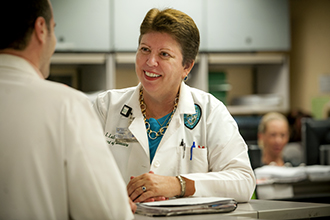Educator uses history to teach diagnostic skills
“I have the best students in the world and that makes my job very easy,” says Dr. Elma I. LeDoux, a professor of medicine and a 1981 graduate of Tulane University School of Medicine.

Dr. Elma LeDoux has innovative approaches to teaching the art of medicine. (Photo by Paula Burch-Celentano)
LeDoux is particularly enthusiastic about the Clinical Diagnosis course, a second-year course that she directs.
“Clinical Diagnosis is amazingly interesting,” says LeDoux, “It is the course that encompasses everything a student might imagine medical school to be.”
The course incorporates such varied elements as learning to examine patients, gaining in-depth knowledge about human organ systems and learning the value of interpersonal relationships between physician and patient.
But to make a fascinating subject even more challenging, LeDoux finds ways to integrate art and history into the curriculum.
In one instance, LeDoux showed her class a photograph of a young soldier from World War I who happened to be an amputee. However, discerning that fact demanded close observation of his posture, of how he was placing all his weight on one leg his good one.
“I hope I taught the students to observe more keenly not just what is seen, but the unspoken,” says LeDoux.
LeDoux was chosen as the 2014 recipient of the medical school"s Teaching Scholar Award. The Owl Club, a medical student organization dedicated to academic excellence, also honored her with the Leon A. Weisberg Excellence in Clinical Teaching Award, and she was named Professor of the Year by second-year medical students.
She fulfills many roles within the medical school in addition to teaching, serving as the faculty adviser for both the Tulane chapter of the Gold Humanism Honor Society and the Tulane History of Medicine Society.
